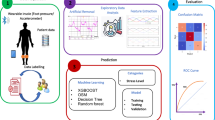Abstract
In practical WSNs, such as biomedical monitoring system applications, the sensor nodes are deployed indoors. The obstacles may exist because of the area setting which may reduce the communicatiuon range of nodes. Those nodes will be isolated from network. In this paper, we present path plannning algorithm for the isolated node with the ability to choose the optimal path for data communication based on fuzzy. In addition, we utilize the RSSI and LQI value in making decision for selecting the optimal path. Our goal is to create high-performance bio-information collection in a biomedical combined WSN system. We focus our contribution on reducing the waiting time for bio-data gathering by diverting the communication path through the empty channel surroundings. Thus, the optimal solution yields the shortest time, not the shortest path. Compared with the traditional algorithm, our algorithm effectively reduces the congestion rate of data transfers, avoids the long waiting times caused by packet loss problems and achieves optimal path planning for objects.

















Similar content being viewed by others
References
Zhang, S., Wu, T., & Lau, V. K. (2009). A low-overhead energy detection based cooperative sensing protocol for cognitive radio systems. IEEE Transactions on Wireless Communications, 8(11), 5575–5581.
Ma, J., Li, G. Y., & Juang, B. H. (2009). Signal processing in cognitive radio. Proceedings of the IEEE, 97(5), 805–823.
Luo, D., Zhu, X., Wu, X., & Chen, G. (2011). Maximizing lifetime for the shortest path aggregation tree in wireless sensor networks. In 2011 Proceedings IEEE INFOCOM (pp. 1566–1574). IEEE.
AlShawi, I. S., Yan, L., Pan, W., & Luo, B. (2012). Lifetime enhancement in Wireless Sensor Networks using fuzzy approach and A-star algorithm. In IET Conference on wireless sensor systems (WSS 2012) (pp. 1–6).
Huang, W., & Ding, L. (2012). The shortest path problem on a fuzzy time-dependent network. IEEE Transactions on Communications, 60(11), 3376–3385.
Marulkar, S., Prabhu, V., Khadilkar, M. (2013). Indoor object localization. In 2013 Tenth international conference on wireless and optical communications networks (WOCN) (pp. 1–5).
Ortiz, A. M., Royo, F., Olivares, T., Castillo, J. C., Orozco-Barbosa, L., & Marron, P. J. (2013). Fuzzy-logic based routing for dense wireless sensor networks. Telecommunication Systems, 52(4), 2687–2697.
Chen, T. C., Chen, T. S., & Wu, P. W. (2011). On data collection using mobile robot in wireless sensor networks. IEEE Transactions on Systems, Man, and Cybernetics-Part A: Systems and Humans, 41(6), 1213–1224.
Guo, Z. Q., Wang, Q., Li, M. H., & He, J. (2013). Fuzzy logic based multidimensional link quality estimation for multi-hop wireless sensor networks. IEEE Sensors Journal, 13(10), 3605–3615.
Jong, G. J., & Horng, G. J. (2017). Fuzzy Inference Engine Integrated with Blood Pressure and Heart Variability for Medical Web Platform. Wireless Personal Communications, 92(4), 1695–1712.
Zonouz, A. E., Xing, L., Vokkarane, V. M., & Sun, Y. L. (2014). Reliability-oriented single-path routing protocols in wireless sensor networks. IEEE Sensors Journal, 14(11), 4059–4068.
Abbasi, A. A., Younis, M. F., & Baroudi, U. A. (2013). Recovering from a node failure in wireless sensor-actor networks with minimal topology changes. IEEE Transactions on Vehicular Technology, 62(1), 256–271.
Garg, A., & Hanmandlu, M. (2006). An energy-aware adaptive clustering protocol for sensor networks. In 2006 Fourth international conference on intelligent sensing and information processing (pp. 23–30). IEEE.
Li, S., Zhao, S., Wang, X., Zhang, K., & Li, L. (2014). Adaptive and secure load-balancing routing protocol for service-oriented wireless sensor networks. IEEE Systems Journal, 8(3), 858–867.
Ababneh, N., Ortiz, A. M., Timmons, N., & Morrison, J. (2012). Energy-Efficient Multicast tree construction protocol for real-time data streaming in WSNs. In 2012 IEEE 8th international conference on wireless and mobile computing, networking and communications (WiMob) (pp. 26–33). IEEE.
Egeland, G., & Engelstad, P. E. (2009). The availability and reliability of wireless multi-hop networks with stochastic link failures. IEEE Journal on Selected Areas in Communications, 27(7), 1132–1146.
Shin, J., & Sun, C. (2011). CREEC: Chain routing with even energy consumption. Journal of Communications and Networks, 13(1), 17–25.
Narvaez, P., Siu, K.-Y., & Tzeng, H.-Y. (2000). New dynamic algorithms for shortest path tree computation. IEEE/ACM Transactions on Networking, 8(6), 734–746.
Qu, H., Yi, Z., & Yang, S. X. (2013). Efficient shortest-path-tree computation in network routing based on pulse-coupled neural networks. IEEE Transactions on Cybernetics, 43(3), 995–1010.
Gao, C., Yan, C., Adamatzky, A., & Deng, Y. (2014). A bio-inspired algorithm for route selection in wireless sensor networks. IEEE Communications Letters, 18(11), 2019–2022.
Ko, J., Gao, T., Rothman, R., & Terzis, A. (2010). Wireless sensing systems in clinical environments: Improving the efficiency of the patient monitoring process. IEEE Engineering in Medicine and Biology Magazine, 29(2), 103–109.
Lee, J. S., & Cheng, W. L. (2012). Fuzzy-logic-based clustering approach for wireless sensor networks using energy predication. IEEE Sensors Journal, 12(9), 2891–2897.
Kulkarni, R. V., Forster, A., & Venayagamoorthy, G. K. (2011). Computational intelligence in wireless sensor networks: A survey. IEEE Communications Surveys & Tutorials, 13(1), 68–96.
Acknowledgements
This work was supported by the “Allied Advanced Intelligent Biomedical Research Center, STUST” under Higher Education Sprout Project, Ministry of Education, Taiwan. The Authors would like to thank Tzu-Chieh Lin and Hsiu-Fen Chiang for collecting experimental data used in the case study.
Author information
Authors and Affiliations
Corresponding author
Additional information
Publisher's Note
Springer Nature remains neutral with regard to jurisdictional claims in published maps and institutional affiliations.
Rights and permissions
About this article
Cite this article
Jong, GJ., Aripriharta & Horng, GJ. Optimal Path Planning for a Biomedical Combined WSN System via RSSI and LQI. Wireless Pers Commun 108, 957–976 (2019). https://doi.org/10.1007/s11277-019-06444-5
Published:
Issue Date:
DOI: https://doi.org/10.1007/s11277-019-06444-5




